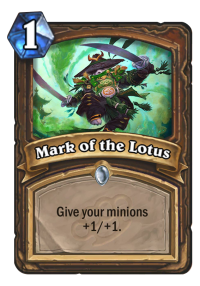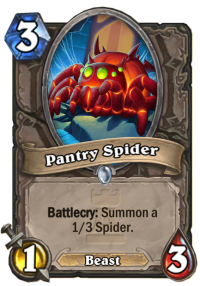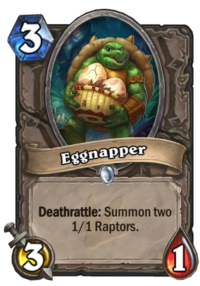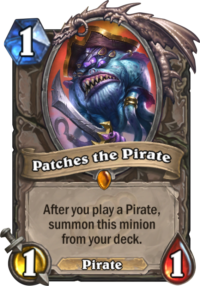Aggro Token Druid is getting more popular and there’s two versions of the deck floating around. One plays with Murloc synergy (which we covered here), and this version that’s more beast heavy and takes advantage of Mark of Y'Shaarj. Sixalix has been kind enough to allow us to re-host their great guide on the deck!
Hello there, I’m Lucio#41676 on the NA Server, and I went from rank 15 to legend playing only aggro druid on my first season of ranked (namely this season).
I’ve been playing Hearthstone casually since Karazhan’s release, but was never really interested in ranked. I mostly made fun decks such as shadowform priest and cheap decks such as zoolock or face hunter. With the release of Un’Goro, however, I decided that I wanted to try ranked in order to see how high I could get, and after using a few decks (tempo rogue, zoolock, pirate warrior, etc.) to get to rank 15, I swapped to aggro druid and never looked back (though I only started recording my stats after rank 10).
Stats and Decklist
- Initial Decklist (rank 10 to rank 4)
- Final Decklist (rank 4 to legend)
- Stats from rank 10 to rank 4
- Stats from rank 4 to legend
- Proof of Legend
Card Choices
In this section, I’ll talk about the cards that made the cut and the cards that didn’t make the cut.
Innervate – Obvious inclusion. Cheating the mana curve allows you to get tempo on board, which is a core part of this deck. Though having this as a two-of in the deck may give you dead hands at times, the consistency it gives makes up for it.
Argent Squire, Enchanted Raven, Fire Fly – These one-drops have all earned their place in this deck due to their efficiency and stickiness. Argent Squire has been a staple of aggressive decks for a long time, and for good reason. In this particular deck, its stickiness allows for it to reliably get buffed by your AOE buffs and make strong value trades. Enchanted Raven is a good target for Mark of Y’Shaarj, and a 2/2 beast for 1 mana is good in and of itself. Lastly, Fire Fly is a very efficient card – it can effectively act as a two-drop and provides two bodies to be buffed, thus making it a shoe-in.
Bloodsail Corsair + Patches the Pirate – Obvious one-drops to add. These strengthen your early game, provide two bodies to be buffed, and help against rogue / warrior matchups. Auto-include.

Mark of the Lotus + Power of the Wild – Druid’s AOE buffs are one of the main reasons why this deck works. These spells are both auto-include, and for good reason. Either of these spells hitting two to four minions creates massive tempo swings and allows you to create sticky and dangerous boards.
Golakka Crawler – I used to run Dire Wolf Alphas over these, but after more testing, I found that Golakka Crawlers were invaluable in warrior and rogue matchups. At worst, it’s a 2/3 beast for 2, but in the best scenarios, you can swing the board in your favor by eating a pirate and creating a totem golem. If you aren’t facing many aggressive matchups, consider taking one out in favor of a different card, but for general laddering, I think running two of these is good.
Mark of Y'Shaarj – I’ve found this card to be solid. It isn’t as core to the deck as Mark of the Lotus or the pirate package, but it rarely doesn’t get value. If you use it on a beast, it’s a +2/+2 buff that draws you a card, and is thus very efficient. Even if you don’t use it on a beast (which, with all the beasts in the deck, almost never happens), you can usually land the buff on a sticky minion such as an Argent Squire and get sufficient value from it.
Ravasaur Runt – Similar to Mark of Y’Shaarj, this card is solid, but not game-winning or core to the deck. Though it’s really annoying when this is your only turn two play and you only have one body on board, you can usually activate its battlecry with all the tokens you have. At worst, it’s a 2 mana 2/2 beast (Enchanted Raven), but at best, it can be a Shielded minibot, 2 mana 2/5, or a haunted creeper, and is thus worth running. 
Pantry Spider – This card is a controversial one. Most aggro druid decks run Eggnapper as their three-drop, but I’ve found Pantry Spider to be a great asset to the deck. Though two 1/3 bodies for three mana may seem underwhelming, they become sticky 2/4 minions after one AOE buff and are solid targets for Mark of Y’Shaarj. In addition, getting two bodies from one card is something you’re never sad about (see: Fire Fly, Bloodsail Corsair). This card’s initially bad statline becomes an amazing one after buffs due to high health allowing for value trades. Though you may cut this in favor of a different three-drop if you so wish, I’ve found this card to be a perfect match for aggro druid.
Savage Roar – Not much to say here. This deck is a token deck, and savage roar thus provides a lot of value. One thing I’d like to say about this card is that you shouldn’t get too greedy with it. I often see aggro druids holding their Savage Roars for more value rather than use it to advance their current board. If using a Savage Roar allows you to make valuable trades and therefore advance your board, use it.
Shellshifter (one-of) – This card has been an MVP for me. Though many people use Defender of Argus as a four-drop, I’ve found Shellshifter to be more consistent and more flexible. Topdecking Argus on an empty board feels horrible, whereas topdecking shellshifter on an empty board allows you to regain board or set up for lethal. Choosing between a 3/5 taunt or 5/3 stealth often comes down to what you need. Do you want to protect your tokens to set up for a Mark of the Lotus next turn? Are you trying to push in that last bit of damage face? Overall, this card’s flexibility and beast tag make it worth running (at least as a one-of).
Swipe – This card is too solid to pass up. Though I initially didn’t include this on my climb to rank 5, it’s proven itself since then. It helps both as situational burn or a solid anti-aggro tool, and almost always helps to advance your position within the game.
Bittertide Hydra (one-of) – Oh boy. This was the card I was the most excited for when Un’Goro dropped. It’s been a very good card, and dropping it against a low HP quest rogue on turn 5 just after they finished clearing your board feels amazing. However, I found that despite its ability to help close out games, running this card as a two-of hurt my matchups against Zoolock and Hunter to much, as they could just repeatedly slam their minions into the Hydra until I died. On a secondary note, watching your Hydra get killed by volcano always feels bad
Living Mana (one-of) – This card was severely underrated before its release. Similar to Bittertide Hydra, it helps to close out games and helps create massive board swings. When using this card, make sure to keep AOE buffs / savage roar / innervate in your hand to set up for the turn after. Though I wish I could experiment with running this card as a two-of, the truth is that I don’t have enough dust to craft a second one. Feel free to experiment with this card. (Note: When setting up for a living mana turn, make sure to use all the mana you can before using living mana, as it consumes all the mana crystals it can. For example, if you’re at seven mana on an empty board, you can use your hero power before using living mana and still create seven tokens.)
Now that I’ve talked about the cards that made the cut and the reasons why they did, let’s talk about a few cards that didn’t make the cut.
Finja Package – I found that including a murloc package did nothing but decrease the consistency of the deck. Though getting massive swing turns by innervating Finja out on t3 may be fun, it’s simply too inconsistent to rely on. Including a more reliable early-game package in the form of beasts (i.e. Ravasaur Runt, Pantry Spider, Crawler) over the Finja package felt a lot better, as though it was not as swingy, its early game was more consistently explosive and thus more reliable. 
Eggnapper – This card was almost good enough for the deck, but I couldn’t find enough space for it. Pantry Spider feels like a more reliable version of this, as it provides the two bodies instantly rather than in the form of a deathrattle. In addition, the two bodies it provides are more sticky than the ones packaged into Eggnapper, and I thus feel as though this card is almost good enough, it is not quite good enough.
Tortollan Forager – I haven’t done enough testing with this card yet, but getting a 2/2 body for 2 is not something you are looking for. In addition, the card you get from it has to have an attack of 5 or more, making this card more suited to a midrange playstyle. With this deck, you will most likely lose the board by turn 7 to turn 8 and are thus trying to win before that state. Tortollan Forager does nothing to help the board during this time and I thus don’t think this card is good enough.
Playstyle, Mulligans, and Matchups
This deck plays more like a zoolock than a pirate warrior. You want to be fighting for board during early game, as your strength comes from landing AOE buffs on a big board of minions and thus apply pressure face. During the early turns, you want to make value trades and protect your tokens as much as possible. Every body matters when it comes to AOE buffs. In addition, make sure to take note of your opponent’s class and their respective AOE. (Play around swipe from druid, thalnos + fan from rogue, maelstrom / storm from shaman, etc.)
In most matchups, you want to be looking for an early curve. Any 1-cost minion is an auto-keep (unless you already have a one-drop, in which case it can be better to look for two-mana and three-mana minions. It’s ok to keep Fire Fly along with another 1-cost minion, as it can effectively function as a two-drop. On the coin, feel free to keep Pantry Spider if you already have a one-drop, as going one-drop -> coin + pantry spider is great to contest the board early and can set up for a big swing turn with AOE buffs. 
Lastly, if you draw Patches – don’t tilt and immediately put him on the board. Immediately dropping Patches onto the board only provides 1 extra damage. Hold him in your hand until you have a swing turn and / or savage roar turn, as he can represent 2 – 4 additional damage to use for a value trade or push for face damage. I have won multiple games due to the surprise factor of this strategy (i.e. using patches + double roar on turn 7 with an empty board to close out the game with a nine damage burst). Remember: in this deck, every single token is valuable, and should be treated as such.
Now that we’ve gone over the general playstyle and mulligan of the deck, let’s get into specifics. If I do not outline a specific matchup, it is due to my lack of experience in that matchup.
Aggro Druid (4-0)
The mirror matchup is all about getting board. I won these matchups due to my opponents getting greedy with their Savage Roars and attempting to push damage to my face without control over the board. If you get a sticky board and remove theirs ASAP, you will almost always win. Don’t leave any minion on their board, as their AOE buffs are destructive. Mulligan for multiple bodies such as Fire Fly, Bloodsail Corsair, and Pantry Spider, and try to beat them on board.
Ramp Druid (1-0)
Don’t really have a sizable sample pool for this matchup, but the one ramp druid I went against was Disguised Toast. I managed to get a sizable board and push enough damage to face to end the game with Hydra + Living Mana before he got his big taunts down. Overall, this matchup seems to be in your favor so long as your opponent does not drop big taunts too early on. Abuse the early game to set up a a big board and punish the ramp druid for not doing much early game. Feel free to keep Innervate + Hydra in this matchup, as they have no way to punish you for dropping an early 8/8.
Midrange Hunter (5-5)
This matchup seems fairly even, though it is slightly in the Hunter’s favor. If you get board early on, you will most likely win, but hunter has many tools to punish you in the form of Unleash the Hounds, Nesting Roc, and Scavenging Hyena. Go for value trades, but watch your life total, as Hunters can often have surprising burst (i.e. Unleash the Hounds + double KC + double Hero Power over two turns). Set up turns to swing the board in your favor and try to always have enough tokens on board to contest his in the event of a topdeck Mark of the Lotus / Power of the Wild. This is one of the matchups wherein innervating out an early Hydra is more detrimental than it is beneficial, as they have many tokens they can run into your hydra to rush down your face and / or boost their hyena. This matchup is very draw-dependent, and as such, you should mulligan for the most reliable early curve you can.
Freeze Mage (1-2)
You’re unfavored in this matchup, as Freeze mage (the most common mage deck on ladder ATM) has many tools to slow and stop your aggression. There’s not much you can do other than set up a medium-sized board and try to push as much face damage as you can before they start freezing your board every turn. The reason I say a “medium-sized” board is because you want to hold some tokens in your hand to play around Frost Nova + Doomsayer, as you have almost no way to deal with a Freeze + Doomsayer save for savage roar / swipe shenanigans. As long as the mage draws badly, you can often rush down face by turn 5 / turn 6 due to their lack of board presence. If the game goes any longer, however, your chance of winning decreases drastically. As such, you want to mulligan for early drops very aggressively and pray that they draw badly.
Paladin (2-0)
Went against two midrange murloc paladins on ladder, and both were very easy matchups. Your board presence more than outvalues theirs, so abuse their early game to set up a big board and then push face. If the game goes to turn 7/8, I would assume it isn’t common to lose to Tirion Fordring / Ragnaros, Lightlord. Mulligan for your early game and feel free to keep AOE buffs in this matchup, as you want to be protecting your board from Consecration.
Miracle Priest (3-0)
As long as they do not get an explosive start, you should be fine. Miracle priests don’t run AOE and are looking to combo you down with a big minion + Inner Fire. This has the side effect of making their early game very inconsistent, which in turn makes this matchup very easy. Set up a big board early, buff it up, go face with savage roar. The only trades which you should bother with in this matchup are Northshire Cleric and Priest of the Feast (within reason). Northshire Cleric and PotF both provide recursive value in the form of draw and healing to face respectively. As such, you want to deal with these minions as fast as possible within logical reason. Don’t bother killing off half your board in an attempt to kill their Priest of the Feast if you can push face and set up two-turn lethal, but make trades into these minions if it makes sense to. Mulligan and play similarly to the paladin matchup – get bodies on board, buff them up, push face while making smart trades.
Quest Rogue (11-0)
The existence of quest rogue is one of the reasons why this deck is so good for climbing. Quest rogues lose tempo early game by bouncing minions between their hand and the board, and you can thus use this time to set up a massive board and push face before they have the chance to react. None of the quest rogues I went against ran any form of taunt or healing, so feel free to push face. Most of their minions are small and meant to gain value post-Crystal Core, so you usually don’t have to make trades after turns 1-3ish. Mulligan very greedily, and look for Golakka Crawler, Bloodsail Corsair, and Pantry Spider, as you want to get as many tokens on board as you can.
Elemental Shaman (2-2)
Though I do not have a very big sample size, this matchup feels biased in their favor. If they draw into their AOE and taunts, it often feels very one-sided in their favor. However, getting a board to stick and bursting them down with Savage Roar is a strategy that I found to work. You will often lose the board by around turns 5-6, so aim for big AOE buff / Savage Roar turns before then and attempt to close the game out with Living Mana. I would recommend against playing Bittertide Hydra, as their large amount of AOE and removal makes it a detriment. (In addition, I ran into one running volcano. That hurt.)
Zoolock (0-2)
Though I went 0-2 against zoolocks on ladder, I feel as though this matchup is relatively even (if I recall correctly, I also drew badly in both games). Since both of you are looking to set up a big board, make value trades and try to get AOE buffs down as fast as possible. Do not get greedy with them, as this matchup is all about board control. Using Mark of the Lotus on a board with only two minions may feel bad, but if it sets up for two value trades, it is worth it. Mulligan for a very early curve and look to outpace them on board.
Pirate Warrior (8-1)
The list I’ve crafted is very heavily teched against aggro, and it shows in this matchup. Bloodsail Corsairs and Golakka Crawlers are guaranteed to get value, so look for those. Set up a big board, make value trades, and try to conserve damage to your face. In most cases, you will have won the board by turn 3 – 4, and the pirate warrior will be forced to go face. This is why this deck is so good against pirate warrior – you’re allowed to set up a big board for turns with Mark of the Lotus and Savage Roar and thus SMOrc him down better than he can SMOrc you down. Remember, in this matchup, board control is key. In a pure face race, the warrior wins, but with a sticky board of minions, you will outpace him every single time.
Quest Warrior (2-5)
This matchup is very polarizing for you. One of the games I won was due to drawing the nuts, and the other one was due to my opponent disconnecting. Quest warrior’s ability to set up big taunts, constantly clear the board, and constantly armor up past lethal range makes this matchup very unfavorable for you. However, if you set up a strong board and push enough damage face, you can attempt to close out the game before he taunts up too much. If you somehow manage to exhaust them out of resources, you can attempt to end the game before they Brawl / Whirlwind + Sleep with the Fishes your board. In most cases, however, you will lose. Don’t let this tilt or annoy you. Simply take a deep breath and move on to your next game.
To Conclude
I hope you guys enjoyed the guide! If you have any questions, feel free to leave them in the comments or PM them to me. I’ll try to respond to as many as I can. As this is my first post on /r/competitivehs, I appreciate all the feedback I can get. Thanks for reading and good luck on the ladder!

















/rating_1_half.png)
/rating_2_off.png)


Funny, i have 1-3 vs quest rogue and 0-2 vs pirate warrior…back and forth R9-R10
3-0 vs hunter tho, got it all backwards
Hello Lucio!!!
Thank you very much for you guide!!!
I took legend from rank 3 for 1 hour using this deck (non-stop victory)! Fortunately I have not met any quest-taunt warrior.
I replace 1 “bloodsail corsair” to “southsea captain” to draw “patches” 2-2 =)
Sincerely yours,
Andrey =)
I replaced 1 “bloodsail corsair” to 1 “southsea captain” to draw “patches” 2-2 =)
I really enjoy these types of guides
He plays something like 30 games and writes a guide, omg what the hell
Did you even look at the stats? He went 38-21 with his first decklist and 39-18 with his final decklist for a total of 116 recorded games – and that’s not even counting in the games between rank 15 and rank 10… real solid evidence you got there, bud.
Im really having strugle against midrange hunters? I seem to face them really often, like 50% of the matchups are midrange hunters. Anyway I could tech this deck to compete better against midrange? Or should I change whole deck to something else for climbing?
I swapped -1 swipe for +1 living mana. Is this a wise choice? I find it difficult playing without 2 LM’s. If that’s a bad swap, what other options are there for adding another LM.
11-0 against Quest Rogue?
Why hello there ( ͡° ͜ʖ ͡°)
Very well written, thanks a lot. Going to try this immediately.
Seems good, since im stacked on a point with 80% quest rogue ill definitely try this, ill post my record later. Thanks for posting it.